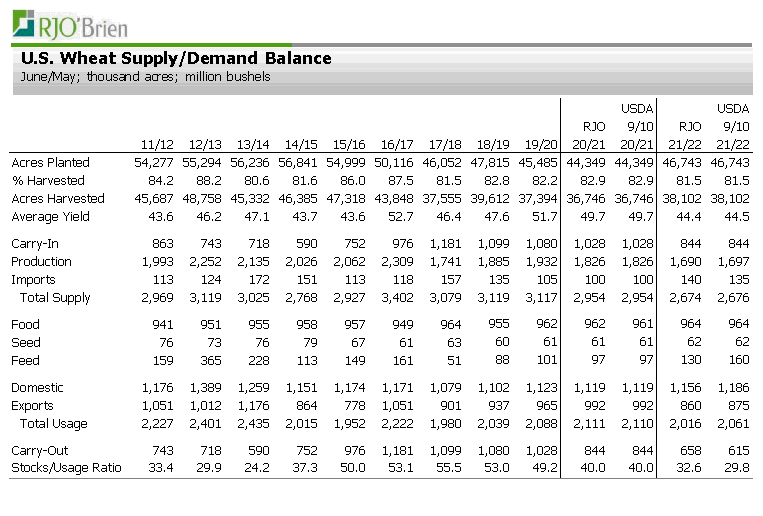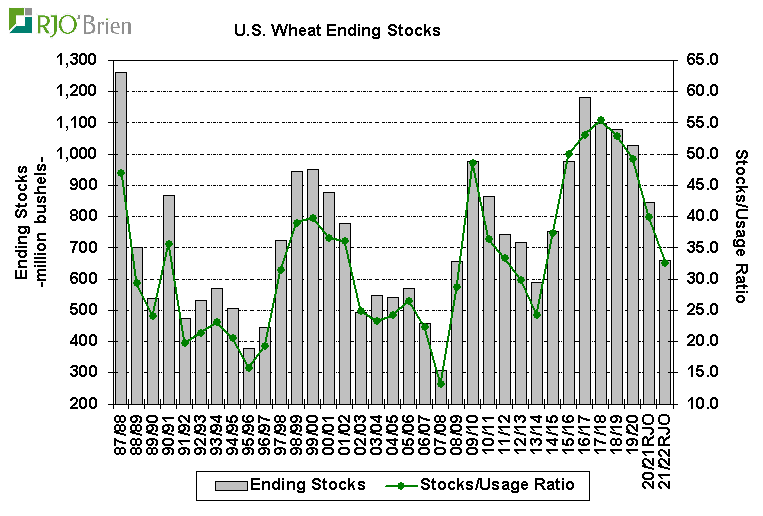The USDA’s quarterly Grain Stocks reports are notorious for providing surprises to the grain markets and with the U.S. corn and soybean balance sheets, in particular, sitting with historically low stocks levels, added caution is warranted heading into next week’s reports. Wheat should not be overlooked either as the combination of the Grain Stocks report and the USDA’s release of the Small Grains Annual Summary report, revising this year’s U.S. wheat crop estimate, presents added risk potential, as well.
Wire services have not yet published trade estimates for next week’s reports. We will post a summary of the estimates on Market Insights as soon as available.
Corn
As we head into the USDA’s quarterly Grain Stocks report, it is impossible not take note of the fact the last two September 1 Grain Stocks reports for corn were sharply below expectations with last year’s report coming in 255 million bushels below the average trade estimate and the 2019 report 314 million bushels below average expectations. Despite the significant “bullish surprises†the last two years, corn prices only reacted modestly with December corn closing 14.25 cents and 16.5 cents/bushel higher on the day the last two years. However, the U.S. corn balance sheets were materially different at the time with burdensome ending stocks near 2.0 billion bushels on both occasions vs current 2020/21 ending stocks projections near 1.2 billion bushels and an 8-year low. Needless to say, should another comparable surprise be seen in next week’s Grain Stocks report for corn, the market’s reaction would very likely be much more substantial than experienced the last two years.
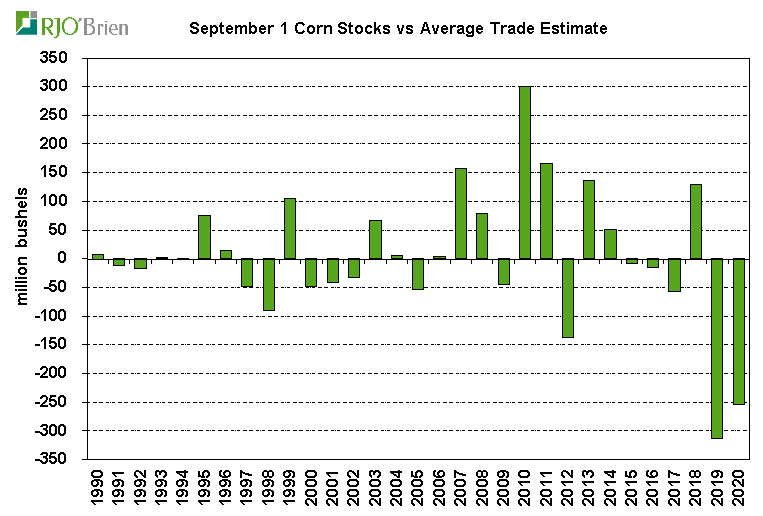
Looking at the specifics, and starting with “known†usage, official August corn for ethanol data and export data will not be available until after the Grain Stocks report is published, so there will still be a little wiggle room in that regard, but we see 4th quarter (June-Aug) U.S. corn exports at 593 million bushels vs 548 million last year, for 2020/21 total exports of 2.745 billion bushels – exactly in line with the USDA’s current projection – and 4th quarter corn for ethanol usage at 1.303 billion bushels vs 1.215 billion last year, for 2020/21 total usage of 5.028 billion bushels vs the USDA’s current 5.035 billion bushel estimate. Additionally, we see June-Aug food usage at 355 million bushels vs 368 million last year following the 2% year-over-year decline in 3rd quarter food usage, as well, putting 2020/21 total usage at 1.409 billion bushels vs 1.400 billion last year. All together, total 4th quarter non-feed/residual corn usage is estimated at 2.253 billion bushels vs 2.133 billion last year and the highest since 2017/18.
Now let’s shift to the much more difficult, if not impossible, topic of feed/residual usage… Starting with a quick recap, the 2020/21 marketing year got off to a strong start for implied feed/residual usage with 1st quarter being up 4.5% from last year at 2.751 billion bushels (2.632 billion last year) and the 2nd quarter up 7.9% from last year at 1.422 billion (1.318 billion last year). As the balance sheet tightened and corn prices appreciated, demand rationing accelerated with 3rd quarter implied feed/residual usage declining 12% from last year to 876 million bushels (995 million last year), the lowest for the March-May quarter in seven years. Through the first three quarters of the marketing year, total feed/residual usage of 5.048 billion bushels was up 2.1% from last year’s 4.945 billion bushels.
This brings us to the 4th quarter and, ultimately, what will determine the final look/feel of the 2020/21 U.S. corn balance sheet. Based on the USDA’s current marketing year total feed/residual usage estimate of 5.725 billion bushels, June-August implied feed/residual usage would need to be only 677 million bushels, down 29% (280 million bushels) from last year, in what would be the lowest outright feed/residual usage of the quarter in five years and the largest year-over-year percentage reduction in 4th quarter feed/residual usage in 25 years.
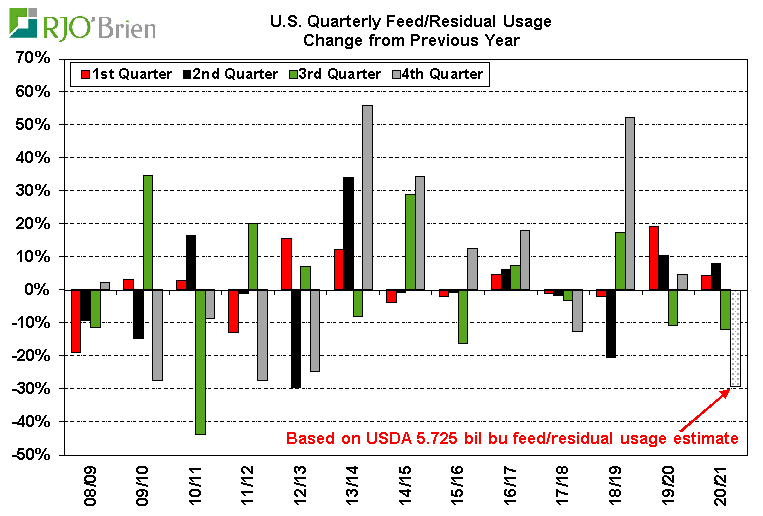
Quite frankly, the task at hand to get anywhere near the USDA’s 5.725 billion bushel annual feed/residual usage is monumental, but without it would put the 2021/22 balance sheet in an even more precarious position should old crop ending stocks prove materially lower than currently forecast. The following chart provides a visual of the difficulty in not only assessing potential 4th quarter feed/residual usage, but also the limited degree of animal number reduction this year relative to the degree of needed demand rationing. Each of the bars represents the year-over-year percentage change in animal numbers by category (cattle, hogs, broilers) during the 4th quarter of the corn marketing year (left axis), along with the percentage change in corn feed/residual usage from the previous year in the red line (right axis). As seen, there are many years when there is a complete disconnect between animal numbers and quarterly feed/residual usage. For example, in 2017/18, cattle, hogs and broilers are all above year ago levels by 2-4%, yet implied 4th quarter feed/residual usage was down 13% from the previous year. Conversely, in 2013/14, animal numbers were lower year-over-year in the 4th quarter and yet implied feed/residual usage was sharply above year ago levels. A quick look across the chart quickly highlights the difficulty in assessing potential 4th quarter feed/residual heading into next week’s report.
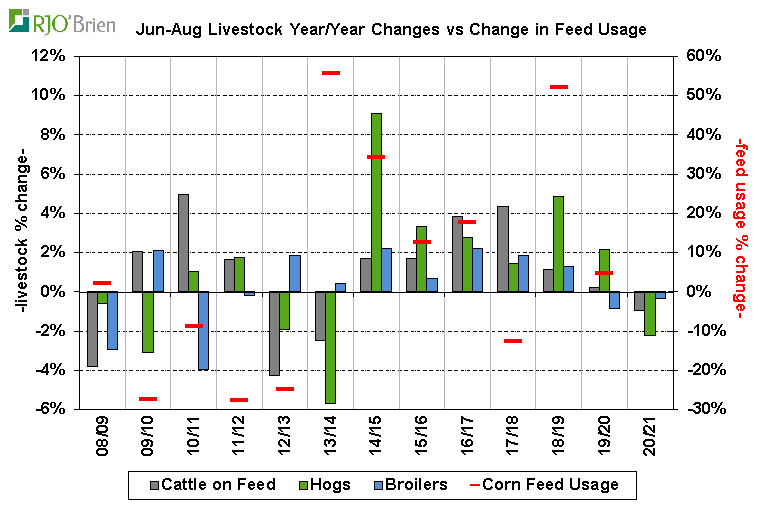
Turning to this year’s situation, as seen, cattle on feed, hogs and broiler numbers were all down year-over-year during the 4th quarter, but only modestly so by 2% or less across the board. In context of the “needed†29% reduction in feed/residual usage for the quarter in order for the USDA’s annual estimate to prove accurate, this presents a rather conflicting perspective. On the other hand, in 2011/12, with animal numbers higher on the year, 4th quarter feed/residual usage was still down a massive 27%. Therein lies the dilemma. Accordingly, while we always like to be able to use statistics thoughtfully and analytically for our ideas heading into a major USDA report, this, unfortunately, is not of the times it is possible given the disconnect between what is “known†and what is attempted to be forecast. With that in mind, we continue to feel a 29% decline in implied feed/residual usage in the 4th quarter from last year is simply an aggressive expectation. Clearly a reduction in feed usage is expected, but just how much is the question. The sharply higher corn prices than in recent years certainly should have helped, but again is not necessarily a quantifiable input in that regard. The relatively low wheat-corn spread during the quarter argues against feed rationing, but is strongly countered by the fact wheat prices were also at multi-year highs and not creating a situation of “cheap wheat†relative to corn as that certainly was not the case. With this being the case, we are looking for a sizable 25% year-over-year reduction in implied 4th quarter feed/residual usage to 720 million bushels, putting our 2020/21 annual estimate at 5.768 billion bushels vs USDA’s 5.725 billion. As this wraps up our 4th quarter demand estimates, we see June-Aug total U.S. corn usage at 2.973 billion bushels vs 3.089 billion last year, the lowest in four years thanks the expected sharp reduction in feed usage.
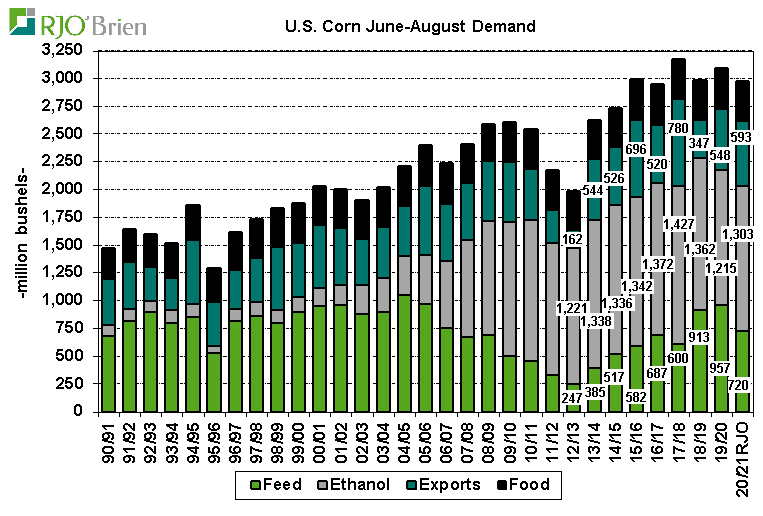
The bottom line puts our September 1 corn stocks (2020/21 ending stocks) estimate at 1.147 billion bushels vs the USDA’s September WASDE report reflection of old crop ending stocks at 1.187 billion and last year’s 1.919 billion. On a final note, we would remind that as a part of the September Grain Stocks report now, USDA moved up the re-assessment of the previous year’s crop from the January Annual Crop Production report, as they have always done for the soybean crop, to better allow for adjustments to be made immediately if deemed necessary by the September 1 corn stocks figure. We don’t see anything of particular note to indicate any more than a minor revision in last year’s 14.183 billion bushel crop should be expected. That was the case last year, as well, as USDA raised the 2019 crop by a miniscule 3 million bushels as part the September Grain Stocks report at the time. Keep in mind, USDA does not issue updated balance sheets as part of the September 30 reports, as those will next be out on October 12, reflecting any necessary changes to the 2020/21 numbers as a result of the Grain Stocks report.
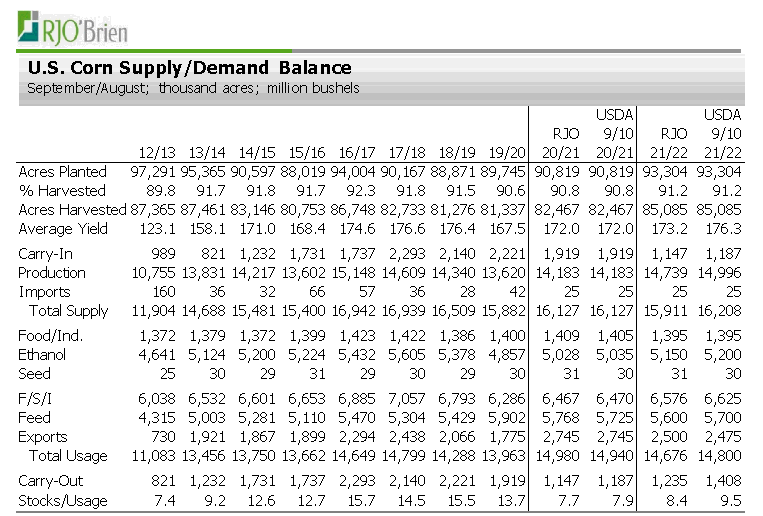
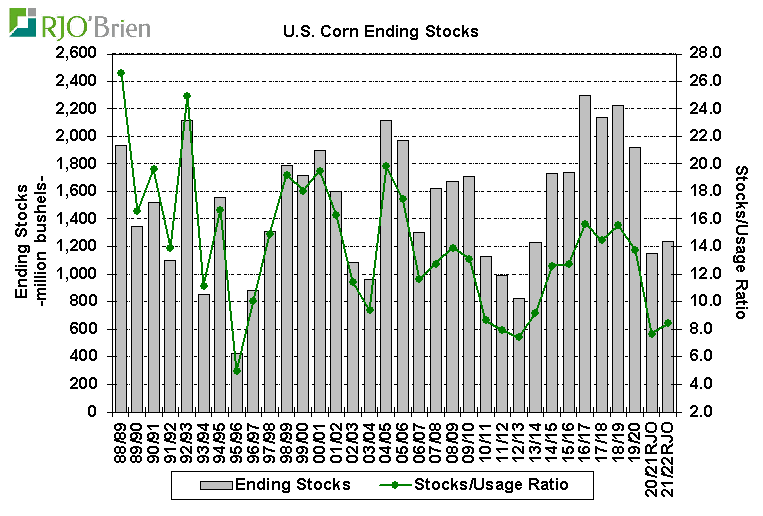
Soybeans
The September Grain Stocks report for soybeans produced “bullish surprises†in each of the last two years, the same as in corn, but as in corn, the U.S. soybean balance sheets were also dealing with burdensome stocks (525 million bushels last year/909 million in 2018/19), muting the fundamental impact of the “lower than expected†stocks reports. November soybeans reacted as would be expected with 30.5 cent/bushel and 23 cent/bushel gains on the September stocks report day the last two years, but given the USDA’s historically low 175 million bushel 2020/21 U.S. soybean ending stocks estimate, another bullish surprise holds the risk of prompting a much more significant market reaction. Conversely, if September 1 stocks prove solidly higher than expected, likely only if last year’s crop was actually larger than currently reflected, as there is no “wiggle room†in the residual already at a minimal 4 million bushels, the near-term favorable weather outlook and generally good early harvest results for this year’s crop could prompt a new round of selling.
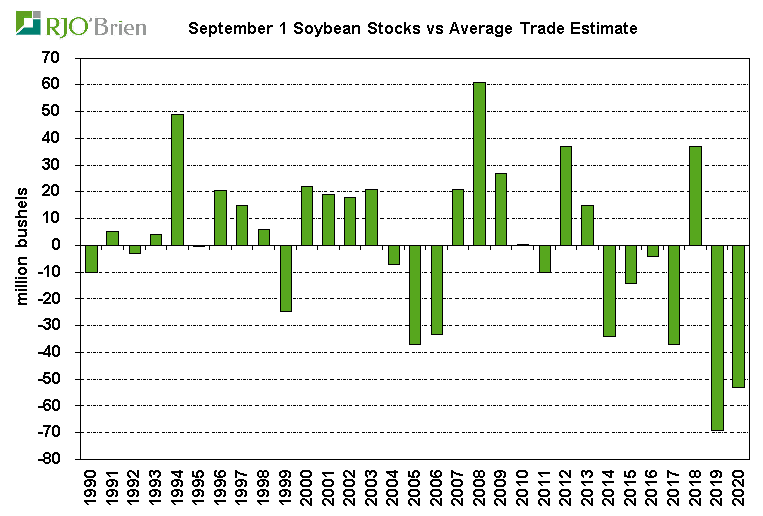
Taking a look at “known†usage, given the historically tight balance sheet and limited available stocks, obviously June-August demand was the lowest in recent years. We estimate June-August crush at 497 million bushels vs 536 million last year and the lowest since 2016/17, while the vast majority of demand rationing fell on exports at only 111 million bushels vs 321 million last year and the lowest since 2013/14. Combined, total known usage of 609 million bushels was down 248 million from last year’s 857 million and the lowest since 2014/15.
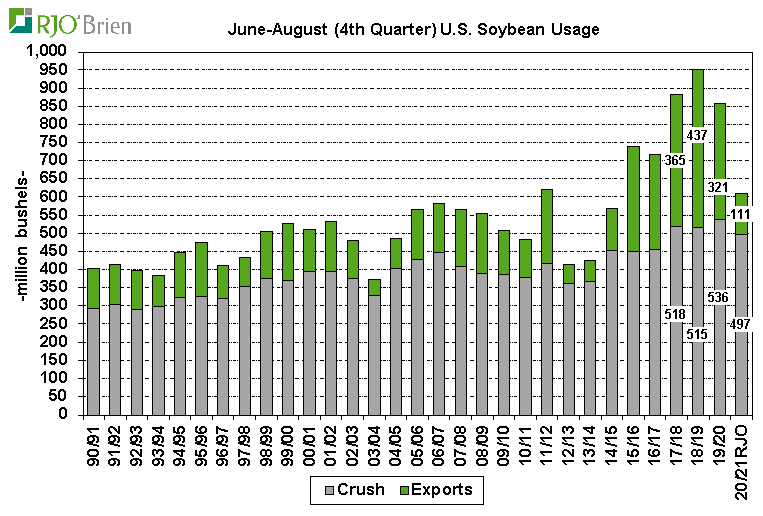
As part of the September Grain Stocks report, USDA always reviews the previous year’s crop size to adjust, if needed, the previously-reported crop estimate with known usage and reported September 1 stocks. In most years, the adjustments are small, as was the case last year with a miniscule 333k bushel reduction in the 2019 crop, while the 2015-2017 crops saw average revisions of only 12 million bushels. However, there are times when considerable adjustments have been made, with 2018 being a notable case in point being lowered 116 million bushels in the September Grain Stocks report. It certainly wasn’t a matter of a supply vs demand conflict within the balance sheet as stocks were in excess of 900 million bushels but it just goes to show there can be notable uncertainties right up until the end. Looking at a potential revision to last year’s crop in next week’s report, we don’t see the need for anything substantial from a balance sheet perspective. With residual usage already assumed to be minimal and known demand allowing for ending stocks to fall within historically low boundaries, nothing appears notably “off.†At the end of the day, though, it is the September 1 stocks figure that everything gets worked backwards from which will ultimately reveal if the USDA’s current 4.135 billion bushel assessment of last year’s crop is correct or not.
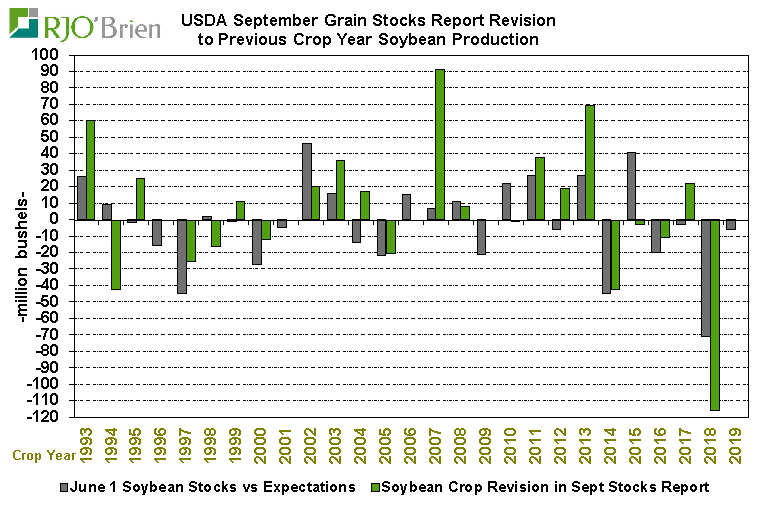
Based on these factors, we’re estimating September 1 U.S. soybean stocks at 155 million bushels vs USDA’s last 2020/21 ending stocks estimate of 175 million.
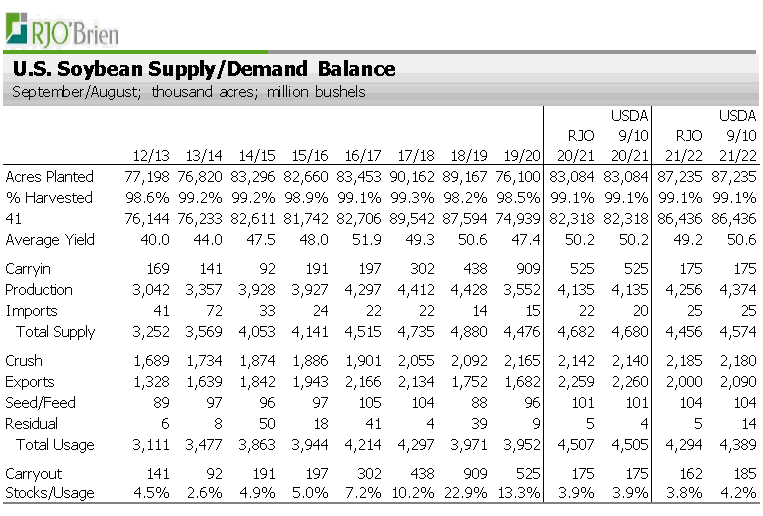
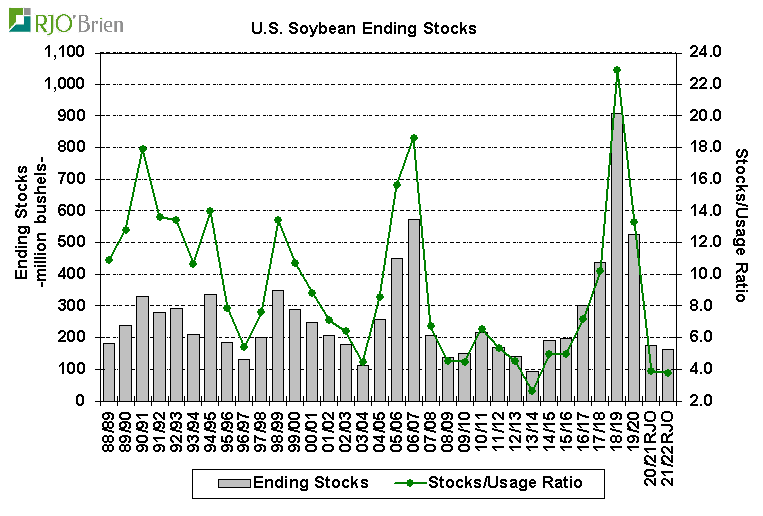
Wheat
Before we can look at the September 1 wheat stocks estimate, we need to re-visit this year’s U.S. wheat crop as USDA’s Small Grain Annual Summary report, providing “final†estimates of the 2021/22 U.S. wheat and other small grains crops, will obviously play a role in the Sept 1 stocks figure. Not unexpectedly, the USDA’s end September wheat crop revisions have not held too many major surprises over the years, but there have been a few somewhat consistent patterns relative to market expectations. The first chart below of the all wheat crop estimate relative to market expectations shows 7 of the last 9 years’ reports being within 23 million bushels of the average trade estimate (6 within 15 million), with the only true surprise being 2015’s 81 million bushel below expectations report. As we look at the winter wheat crop specifically in the 2nd chart, we see a distinct bias for the September revision to be lower than expected, having been so by some degree in 13 of the last 14 years. While most would not be considered major surprises, there is a clear bias. Conversely, the USDA’s September revision of the spring wheat crop has had a bias for coming in higher than expected, having done so in 7 of the last 9 years, including the last four years. Again, while not typically major surprises, it is a clear bias nonetheless.
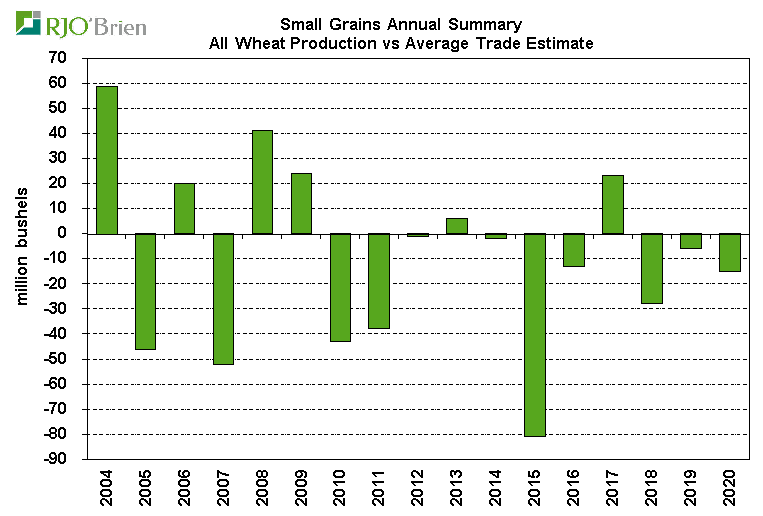
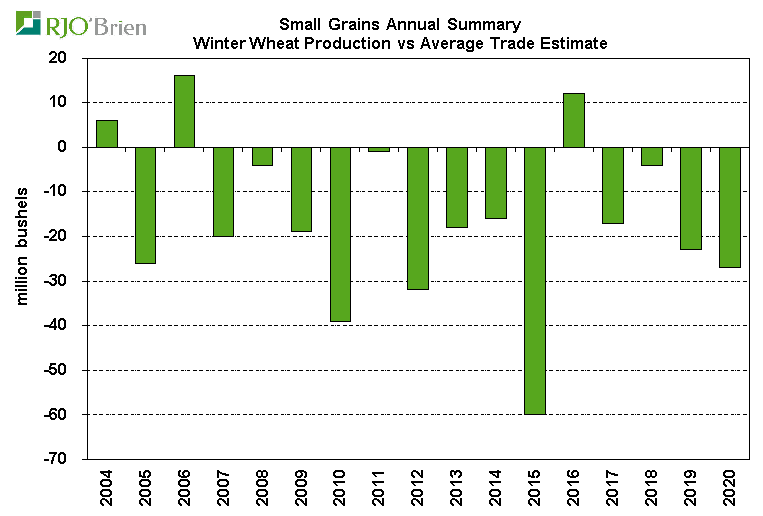
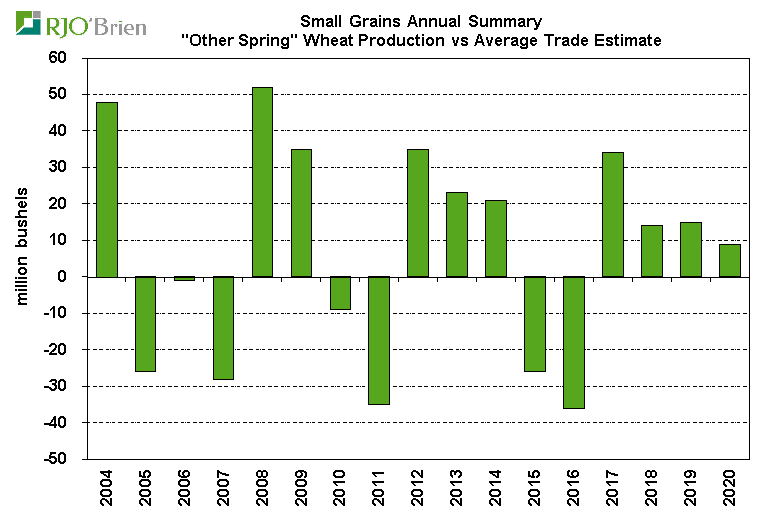
In terms of specific revisions, there has been a clear bias for USDA to lower the winter wheat crop in the Small Grains Annual from the previous estimate in August, having been the case in 13 of the last 14 years, including the last four. However, there has not been any bias in the direction of the USDA’s spring wheat crop revision in the September report, while each of the last 8 years’ September revisions were by 37 million bushels or less. We are not expecting significant changes in the USDA’s wheat crop estimates in next week’s report. While our all winter wheat crop estimate of 1.320 billion bushels is nearly identical to the USDA’s 1.319 billion bushel estimate in August, we see the HRW crop at 783 million vs USDA’s 777 million, SRW 362 million vs USDA’s 366 million and winter white at 175 million vs USDA’s 176 million. We see the “other spring†wheat crop at 336 million bushels vs USDA last at 343 million and durum at 34 million vs USDA’s 35 million. All together, we’re estimating the 2021/22 U.S. all wheat crop at 1.690 billion bushels vs USDA last at 1.697 billion and last year’s 1.826 billion.
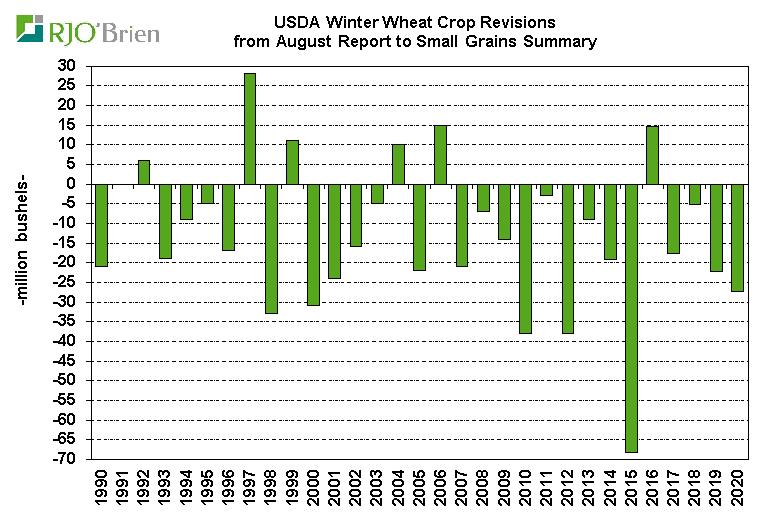
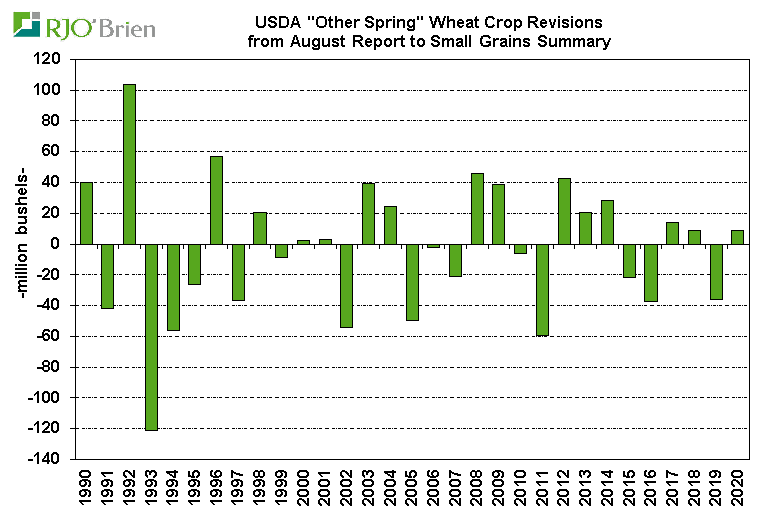
Turning to the September 1 Grain Stocks report, as always, the massive unknown for the 1st quarter (June-August) balance sheet lies in implied feed/residual usage. As we discussed in corn, the relationships/correlations between 1st quarter wheat feed/residual usage and various price factors are extremely vague, if not outright non-existent. The following chart shows 1st quarter wheat implied feed/residual usage vs the wheat-corn spring during the June-August period. As seen, over the last four years, 1st quarter feed/residual usage has been in a fairly narrow range of 165-218 million bushels despite the CBOT wheat-corn spread averaging anywhere from 89-183 cents/bushel during the quarter. Despite a nearly $1.00/bushel difference in the price spread, 1st quarter feed/residual usage has varied only 53 million bushels over the last four years. This year, the CBOT wheat-corn spread averaged only 78 cents/bushel during the 1st quarter, with 2016/17 being the most-recent year with a similar spread at 75 cents/bushel. In that year, 1st quarter wheat feed/residual usage was 266 million bushels, much larger than levels in recent years. However, wheat prices were substantially lower during June-August 2016 than this year, with CBOT wheat averaging $4.34/bushel and KCBT wheat $4.21/bushel during the period vs this year’s $6.86 and $6.55/bushel respectively. While we do feel 1st quarter feed/residual usage may have been larger than recent-year levels, we caution against being too aggressive with expectations. Accordingly, we’re estimating June-August wheat feed/residual usage at 240 million bushels vs last year’s 212 million, but below 2016/17’s 266 million. The shotgun blast-type pattern shown in the following chart shows the difficulty/impossibility of assessing potential quarter feed/residual usage heading into next week’s report. Also keep in mind, combined 2nd-4th quarter feed/residuals are essentially always negative, having been so over the last 21 years, with the last five years averaging -106 million bushels (-95 to -116 million range). Accordingly, following the release of the Grain Stocks report next week and assessing 1st quarter implied feed/residual usage, roughly 100 million bushels should be taken off for a quick ballpark assessment of potential 2021/22 annual usage.

For other more “known†demand categories, we estimate 1st quarter wheat exports at 240 million bushels vs last year’s 272 million and food usage at 239 million vs 242 million. Combined with our feed/residual usage estimate, total 1st quarter wheat usage of 721 million bushels would be nearly identical to last year’s 726 million and comparable to levels in recent years.
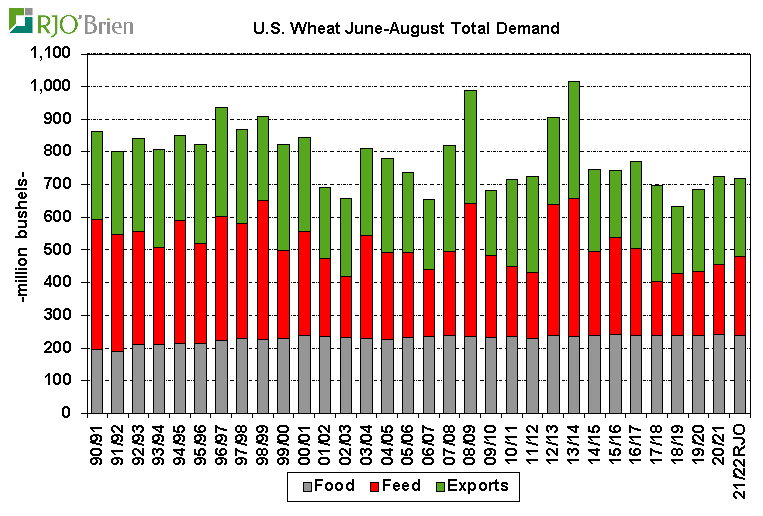
Putting it all together, the combination of our U.S. wheat crop estimate and 1st quarter demand ideas puts our September 1 U.S. wheat stocks estimate at 1.836 billion bushels, down solidly from last year’s 2.158 billion and the lowest 14 years. While fundamentally supportive on face value, and clearly a notable change from recent years, the overall lackluster demand structure leaves the Sept 1 stocks/June-Aug usage ratio at 2.55, again down from last year’s 2.97, but only the lowest in 7 years and pretty much middle of the road in historical terms. The fundamental structure of the wheat balance sheet has certainly improved in recent years, but, in our opinion, is still not at levels considered outright bullish without a stronger demand outlook for U.S. wheat.
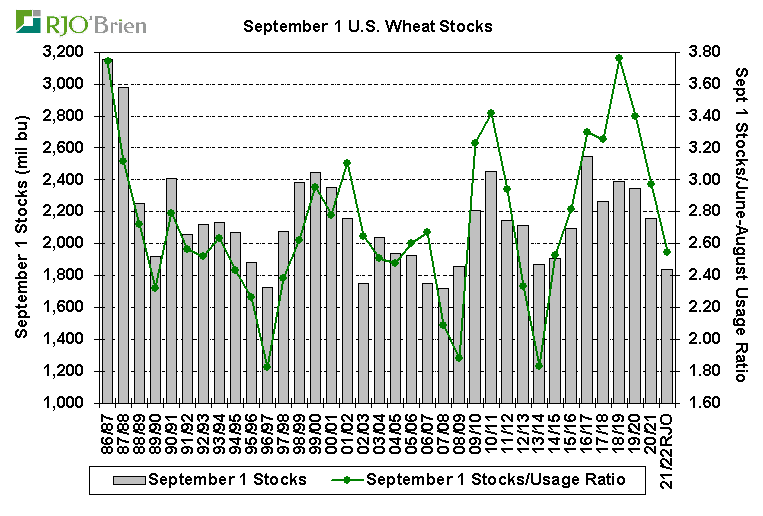
On a final note, while there has not been much, if any, bias in the USDA’s September 1 U.S. wheat stocks report relative to market expectations, there have been plenty of surprises over the years with 75-100 million bushel surprises not being uncommon and several larger than that over the last 10 years.

